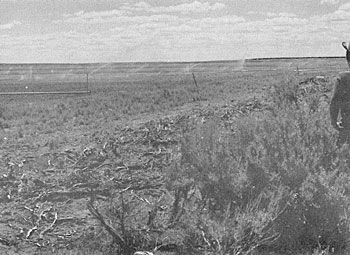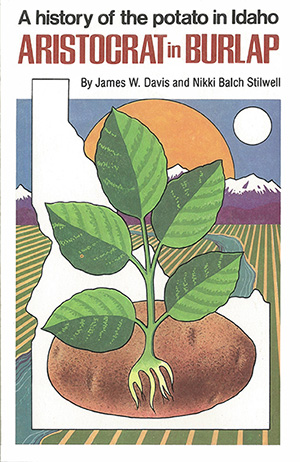 After centuries of sagebrush, potatoes are grown under sprinklers.
After centuries of sagebrush, potatoes are grown under sprinklers.
As a result of the initial problems that developed, Indian Hills entry men were not able to hold their project together financially and an additional investment was necessary for redesign and rebuilding of the project. At this point, the Hood Construction Company entered the picture and supplied technical assistance and money to rescue Indian Hills. It was this corporate intervention that disenchanted the Bureau of Land Management under the premise that Indian Hills was no longer a project owned by individual entrymen exercising their birthright, but by a corporation that had gained title to a large area of low-priced government land. A controversy developed that stalled further desert entry projects for some years.
The Indian Hills situation was finally resolved by the BLM requiring the Hood Construction Company to remove their pumps and property from the project and the land reverted to desert pasture yet to fulfill the green promise of irrigated potato fields.
The largest of the Snake River Plateau projects, and one that showed great promise initially, was the Bell Rapids project. Taking its name from the area on the Snake River where the primary pumping plant was located, Bell Rapids was to bring water to 25,000 acres south of the Snake River opposite the town of Hagerman. The extent of the project was such that it occupied most of the area across the river between the communities of Hagerman and Bliss. As the Snake River land rush got underway, ambitious entrymen began exploring the desert areas very thoroughly.
The originators of the Bell Rapids project were reported to have ridden over the greater part of the plateau south of the Snake River on motorcycles. This area had the preliminary appearance of good land because of the luxuriant growth of brush and comparatively flat topography. Thorough exploration, soil sampling and formal surveys followed, and an engineering feasibility study recommended the development of this largest reclamation project to be privately financed. The water lifts at Bell Rapids vary in the three pumping plants that serve the project. The highest lift is 625 feet. Bell Rapids involves a pumping energy requirement of 50,835 horsepower. Thirteen miles of canals were constructed and 120 miles of buried steel pipe installed.
Another indication of the ambitious planning and scope of Bell Rapids is the fact that 9,000 acres were put under solid-set irrigation systems. Although requiring larger initial investment, solid-set irrigation eliminates sprinkler moving during the growing season and makes control of soil moisture and soil temperature easier.


 After centuries of sagebrush, potatoes are grown under sprinklers.
After centuries of sagebrush, potatoes are grown under sprinklers.